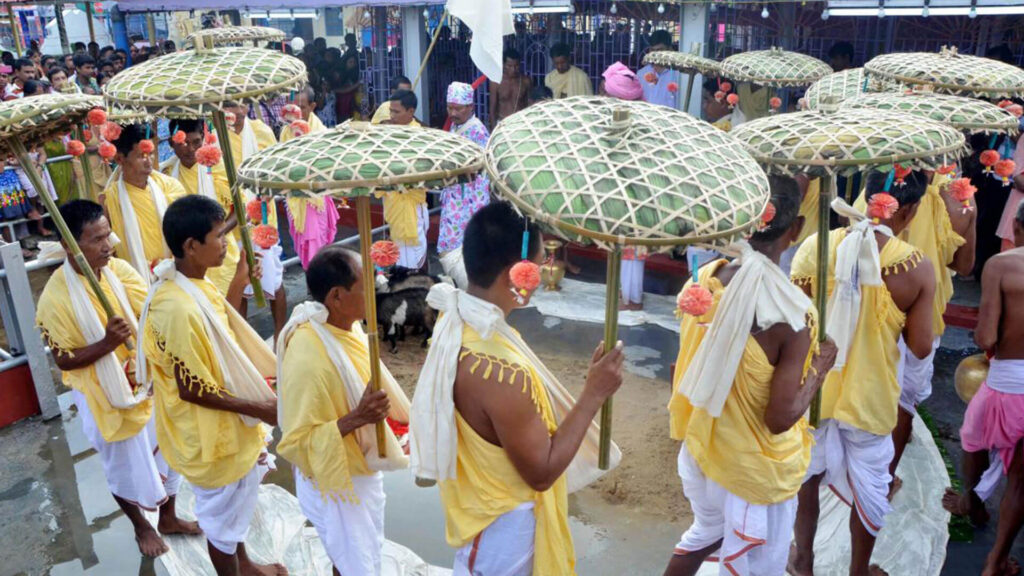India is known for its vibrant culture and diverse religious traditions. Among the many colorful festivals celebrated across the country, Kharchi Puja stands out as one of the most unique and culturally rich festivals of Northeast India. Held annually in the northeastern state of Tripura, this festival is deeply rooted in tribal traditions and Hindu customs, making it a powerful symbol of cultural fusion and heritage. As Kharchi Puja 2025 approaches, it’s the perfect time to explore its cultural significance and what makes it such an important event in the Tripuri community.
Origins and Mythological Background
Kharchi Puja, derived from the word ‘Khya’ meaning sin, is a purification festival dedicated to the fourteen deities (Chaturdasha Devata) of the royal dynasty of Tripura. According to legend, the deities reside in the Old Agartala (Puran Haveli) and are believed to be the protectors of the land and its people. The festival is believed to cleanse the sins of the people and purify Mother Earth, who according to folklore, becomes unclean due to menstruation.
Celebrated with great devotion and community spirit, the festival spans seven days and is deeply embedded in both the tribal rituals of the Tripuri people and mainstream Hindu practices. The unique blend of customs reflects the state’s cultural harmony and pluralistic heritage.
When and Where Is Kharchi Puja Celebrated?
Kharchi Puja 2025 is expected to take place in the month of July, following the Hindu lunar calendar. The celebrations are held in the Chaturdasha Devata Temple located in Old Agartala, about 12 km from the capital city of Agartala, Tripura. The temple becomes the central point of the celebrations, attracting thousands of devotees, tourists, and cultural enthusiasts from across the state and beyond.
Rituals and Celebrations
One of the key highlights of Kharchi Puja is the ceremonial bathing of the fourteen deities in the Saidra River, followed by their return to the temple amidst chanting, music, and processions. The idols are taken out of the temple in a grand procession and bathed with water drawn from the sacred river. This ritual is believed to purify the gods and in turn, purify the land and its people.
The celebration also includes elaborate pujas, animal sacrifices (such as goats and pigeons), and distribution of prasad. While animal sacrifice is a traditional element, efforts are being made in recent years to adopt more symbolic and non-violent forms of offerings.
During Kharchi Puja 2025, the temple complex and surrounding areas are expected to be lit up beautifully, with cultural programs, local handicraft stalls, and food vendors adding to the festive atmosphere.
A Celebration of Tribal and Hindu Unity
One of the most fascinating aspects of Kharchi Puja is the seamless integration of tribal animistic beliefs and mainstream Hindu rituals. The fourteen deities worshipped during the festival include both tribal gods and Hindu deities, symbolizing the co-existence and mutual respect between different faiths and cultures in Tripura.
The Tripuri royal family, traditionally custodians of the deities, also participate in the celebrations, highlighting the continued relevance of age-old customs. This festival provides a rare opportunity to witness the coexistence of monarchy, religion, and local traditions in modern times.
Cultural Programs and Local Artistry
Kharchi Puja 2025 is not just a religious observance but also a cultural extravaganza. Over the seven days, the temple grounds transform into a vibrant cultural fair. Folk dances, music performances, and traditional dramas are staged by local artists and cultural troupes, offering insights into Tripura’s rich artistic heritage.
Artisans from across the region display their handicrafts, including bamboo products, tribal jewelry, and handwoven textiles, which are popular among tourists. Food stalls offer a taste of Tripuri cuisine, including delicacies like Mui Borok, bamboo shoot dishes, and local sweets.
These cultural expressions make Kharchi Puja 2025 not just a spiritual journey but a full cultural immersion.
Tourism and Economic Impact
Over the years, Kharchi Puja has gained attention beyond Tripura, attracting tourists, scholars, and photographers keen to document its rituals and community spirit. With the state government promoting Kharchi Puja 2025 as a key cultural tourism event, local businesses, especially artisans, transport operators, and food vendors, stand to benefit significantly.
The Tripura Tourism Department often collaborates with cultural institutions to organize guided tours, promote eco-tourism in nearby areas, and showcase tribal heritage through exhibitions and documentaries during the festival week.
Preservation of Culture in Modern Times
In a rapidly modernizing world, festivals like Kharchi Puja play a crucial role in preserving indigenous cultures and oral traditions. It serves as a living museum of Tripura’s history, mythology, and societal values. With younger generations getting involved in organizing and performing during the festivities, the festival is evolving while still retaining its core spiritual and cultural essence.
Efforts are also being made to digitize the history of Kharchi Puja, document oral narratives, and promote sustainable tourism to ensure that the festival remains relevant for future generations.
Conclusion
Kharchi Puja 2025 promises to be a vibrant celebration of faith, culture, and community in Tripura. Rooted in ancient beliefs yet alive with contemporary relevance, the festival showcases the region’s spiritual depth and cultural richness. Whether you are a traveler seeking unique experiences, a cultural enthusiast, or someone exploring India’s diverse traditions, Kharchi Puja offers an unforgettable glimpse into the soul of Tripura.
As the festival draws near, one can only look forward to the rhythmic beats of traditional drums, the sacred rituals by the Saidra River, and the festive spirit that binds an entire community in celebration.
Read More : theguestblogs






